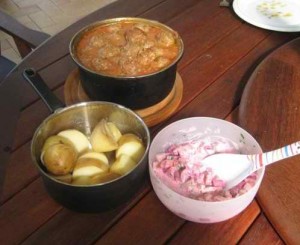.jpg)
.jpg)

The Typical Kitchen – – – – –
We are all familiar with the three main types of cooking methods or ‘kitchens’.
A – the ‘WESTERN’ – electric. Very popular, quick, clean and instantaneous.
B – the ‘EASTERN’ – gas or wok. Fast and hot but a little messy.
C – the ever popular ‘COUNTRY’ or BBQ. A requirement for modern living.
I feel the time is approaching for a CULTURAL RETHINK. We are paying big money for dirty energy that is produced hundreds of kilometres away yet letting FREE clean energy, that is streaming down all over the neighbourhood, waste away. It is screaming at us “Use me! use me! “ with nary a person harnessing it, save for a few rooftop solar hot water systems. (and of course my ‘parabolic cooker’ with a beef silverside bubbling away while my partner is out gallivanting in some shopping mall spending our precious lucre (oh what a waste) . Oops the sun just ducked in behind a cloud)
I suggest that we might integrate an alternative technology into the mix :-
D – the ”’ SOLAR KITCHEN ”” cheap, environmentally clean, easily accessible energy DELIVERED FREE to your door. (Ahh! its coming out again)
Designing a Solar Kitchen
When thinking ‘Solar Kitchen’ as a permanent fixture and a part of a house design, one should consider a number of basic requirements and how serious a lifestyle change you are planning on. A tuned in building designer or architect should be capable of grasping the requirements allowing for retrofitting an existing house or designing a new one incorporating a permanent solar kitchen. Since most solar cooking is performed outdoors, I advise building a permanent semi-open structure either attached to the house or free standing, providing shelter yet allowing easy access to sunlight. This structure could also include the iconic BBQ which no modern household can survive without.
( Oh Oh she’s back again and not looking happy. I was instructed to turn the cooker to track the sun but I forgot – bloody computer )
1 . Best location in the yard for a solar structure is on the North to North Westerly aspect for houses in the southern hemisphere nations or South to South Westerly aspect in the northern hemisphere.
2 . A patio or alfresco structure with area large enough to accommodate a fixed or mobile ‘solar cooker’ and a BBQ or firewood oven. It would benefit the user to have the floor extending past the roof outline where a mobile unit may be moved to get clearer access to sunlight.
3 . Be mindful of shadow forming structures or trees and shrubs that may interfere with access to sunlight, remembering that trees do grow and could create a shadow nuisance in years to come.
4 . Landscape and fence your yard thoughtfully to shield your neighbours from any annoying glares and reflections, and shield you from neighbours stares. I suspect that my neighbours consider me a little off beat constantly setting up these strange contraptions on my driveway and forever cooking.
5 . Keep solar kitchen in near proximity to the main domestic kitchen. Any long walks may discourage regular use.
Health and Safety
Solar cookers when used properly, safely and nutritionally cook all types of food. As with any cooking method care should be taken to maintain food safety and hygiene.
Dark sunglasses should always be worn by the ‘Chef’ and be available to all spectators and assisting Chefs, since reflective glare, even occasional, can injure your eyes.
Because most of the panel cookers are lightweight, they can be easily toppled over, either by bumping into, or by a strong breeze and should be set up in open visible locations, not on popular traffic corridors.
One should be extra vigilant when all children are present. Caution should be taken around hot pots. Special common sense safety procedures should be formulated, documented and enforced on all users and bystanders. Solar Cookers may look cute but these are serious devices NOT TOYS.

Solar cooked potatoes and meatballs in tomato sauce
